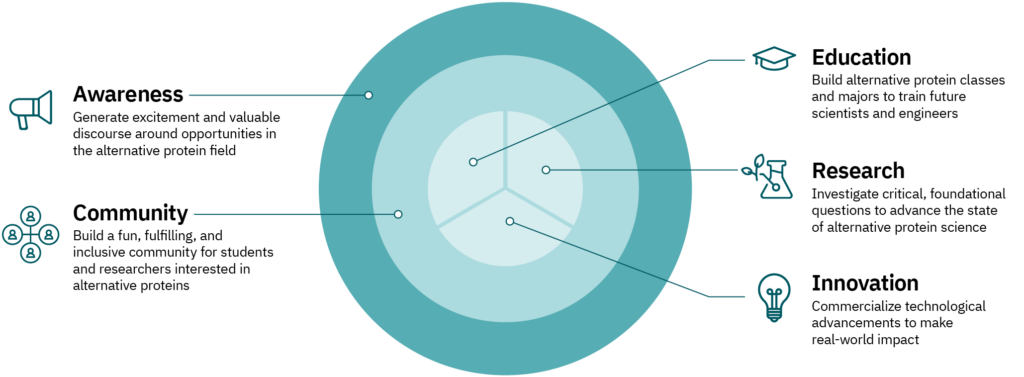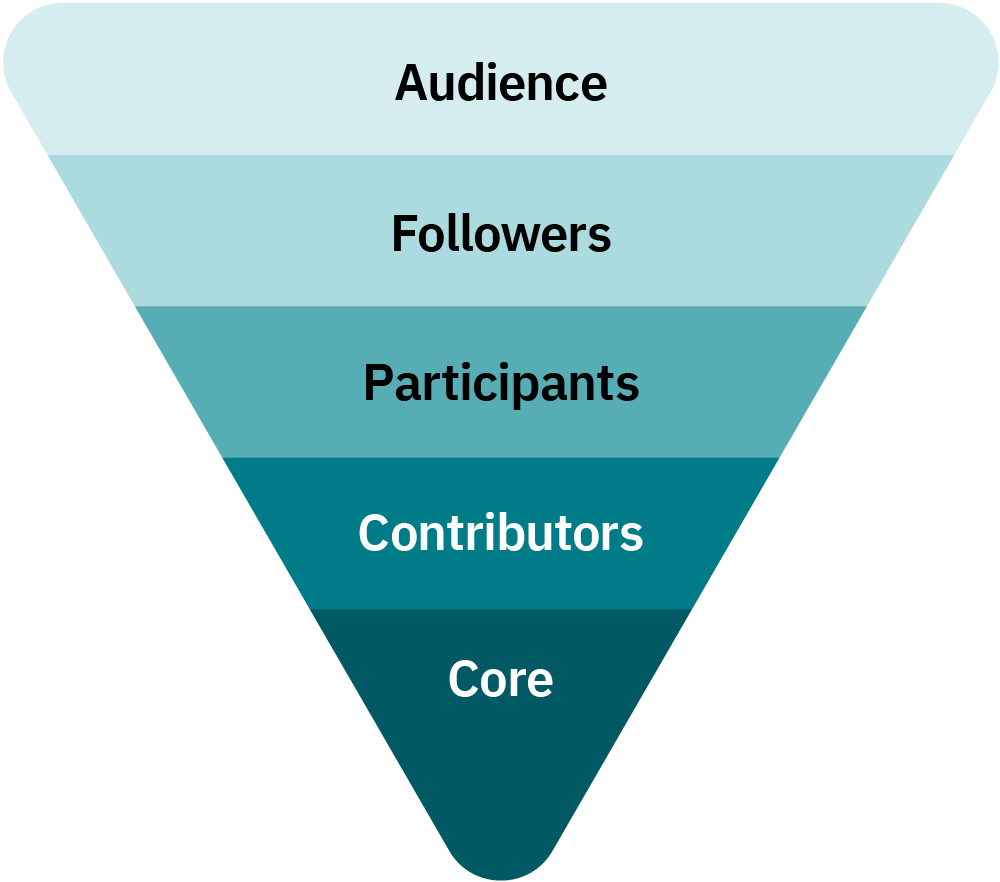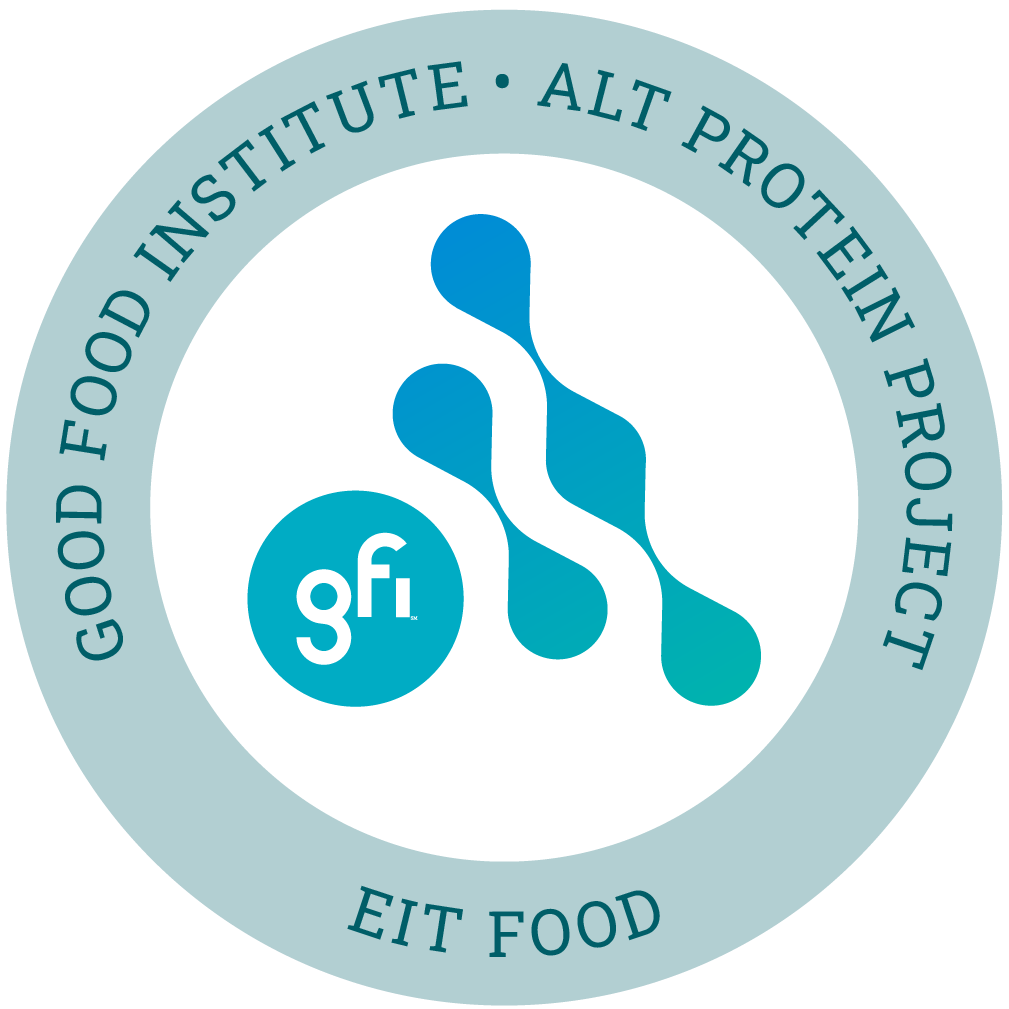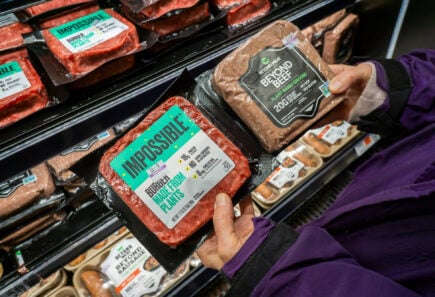Generating awareness about alternative proteins
In our guide, we lay out the steps to help you raise awareness and excitement about alternative proteins throughout your university and the online community. Learn how to become a thought leader, leverage existing platforms to promote alternative proteins, facilitate discussion groups, and more.
Introduction to raising awareness
The importance of raising awareness and excitement
It helps build the movement on campus
Social and technological movements are driven by people, and the global protein transition is no exception. A key bottleneck is the sheer size of the movement—we need more hands on deck. An important group to reach is people with relevant backgrounds and skills who lack exposure to the alternative protein space. It’s also critical to engage students and researchers who are already interested in the field, as they may be unaware of the momentum of the movement at their university. By raising awareness, more talent can be brought in and better connections can be built to navigate the challenges and opportunities associated with advancing our field.
Universities are highly effective places to promote the alternative protein field. These are formative years for students who are discovering their values and how they want to shape the world. Surrounded by new ideas and worldviews, many students are keen to explore emerging career paths. This gives us an especially effective opportunity to inform students about alternative proteins and potential careers. By raising awareness at universities, we can also introduce researchers to new career options and research opportunities.
Many universities already have key elements of a thriving alternative protein ecosystem, like relevant courses, nearby industrial hubs, and research centers. However, academic silos can limit an institution’s full potential as an alternative protein leader. Generating excitement and stimulating discourse can help break down these walls and facilitate collaboration. In terms of the Alt Protein Project’s programmatic goals, spreading awareness is an enabling objective that allows us to accelerate research, education, and innovation.

It attracts talent and resources into the field
Because the alternative protein field is still in its early stages, amplifying the discourse online can have tremendous impacts beyond your university. Raising awareness makes institutions more likely to prioritize the field, leading to increased funding and an influx of talent—both of which are critical to advancing an emerging field. See how APP chapters are already raising awareness throughout their campuses on the APP impact page.
To raise awareness and stimulate discourse, key opportunities for student movement-builders include:
- Thought leadership: Publishing thought leadership content and having a strong social media presence enable student groups to demonstrate their alternative protein expertise and position themselves as leaders in the space. This can lead to media coverage and other features, which further magnifies the conversation.
- Leveraging existing platforms: Instead of planning events from scratch, students can ensure alternative proteins are represented in hackathons, social innovation competitions, conferences, and other established events on campus. Similarly, getting alternative protein content published in relevant journals or newsletters is an effective way to raise awareness in existing scientific communities.
- Organizing events: Discussion groups, fellowships, and conferences are just a few ways to stimulate discourse and bring people into the movement. It’s important to consider whether planning a large event is the best use of your student group’s bandwidth. Leveraging existing platforms typically requires fewer resources and can have the same (or greater) impact.
The ideal awareness ecosystem
The funnel model for movement-building
As an early advocate for alternative proteins, there may have been a time you felt like the only person at your campus who cared about the movement. While this is common in emerging fields, it can be an isolating and disheartening experience. The goal of raising awareness is to surface others who are equally excited about the future of food! Picture a college campus brimming with conversation about alternative proteins—what would this look like?
Let’s think about this in terms of the Centre for Effective Altruism’s funnel model for movement-building, pictured below. The funnel represents levels of engagement, and individuals outside the funnel have never heard about alternative proteins. The first layer (audience) consists of people who are first learning about our field, and the last layer (core) includes subject matter experts who are dedicating their careers to alternative proteins. Generating awareness brings people into the funnel and toward the core layer.

Building an audience
At a typical university, the majority of people reside outside the funnel, but in an ideal awareness ecosystem, everyone has at least heard about alternative proteins. Even if a student doesn’t seek out alternative protein events, they become part of the audience through other university spaces focused on issues like climate, public health, and food security. There are many ways for members of the audience to become followers, or people who are starting to engage with the alternative protein field. This can take the form of attending events or simply exploring podcasts and other online content.
As followers continue to engage with alternative proteins, they become participants and contributors, meaning they have a deeper understanding of the movement. These individuals move down the funnel by participating in alternative protein conferences, courses, and research projects. A thriving awareness ecosystem enables success in our other programmatic objectives—education, research, innovation, and community—so there’s an abundance of opportunities to get involved.
Moving toward the core layer
Most importantly, awareness turns into expertise as people move toward the core layer, joining others who are actively solving challenges in the alternative protein space. Beyond having a general understanding of the alternative protein space, these individuals have a strong grasp of key white space opportunities and are actively working to address the challenges the field faces. By surfacing white space opportunities and illuminating bottlenecks, we can make sure students, scientists, and innovators know what’s needed to advance our field and are equipped with the tools and resources to maximize their impact.
Explore our advancing solutions for alternative proteins database to find ideas for new startups, commercial ventures and products, research projects, ecosystem support, and investment opportunities. Apply the academics filter to find solutions where universities are relevant actors.
Sharing alternative protein resources
As an Alt Protein Project student leader, people on campus will consider you an expert on alternative proteins. This means your leadership team should feel comfortable connecting individuals and groups with existing resources to bring them closer to the core layer. Keep in mind that people may be starting from very different points along the awareness funnel. To help newcomers get up to speed, refer them to our student resource guide and our essentials page.

Developing your strategy
Awareness building may be the most common objective of all cause-driven student groups. There are countless ways to spread awareness and countless models to learn from, so it’s important to focus your efforts on the most effective strategies for your student group. This section is designed to help you select awareness-building activities with the highest potential to accelerate your long-term goals.
Mapping the awareness landscape
Get to know your campus resources
To begin, we recommend taking some time to identify the organizations and resources your student group can utilize to advance your awareness goals. Mapping these areas will illuminate the ways your group is uniquely positioned to stimulate the alternative protein discourse.
To build your thought leadership strategy, these are the organizations to map at your university:
- Office of communications: Sometimes also called the office of marketing or strategic relations, this team is responsible for shaping the university’s overall communications strategy. They typically manage the official website, social media accounts, and media relations. Their staff can promote your group’s thought leadership pieces, connect you to your target audience, and provide media training. See examples at the National University of Singapore and Cal State San Marcos.
- Student-run media groups: These might include newspapers, podcasts, mailing lists, and other media platforms powered by students. They can help your group broadcast news about the alternative protein movement to broader student audiences. Two examples of student-run newspapers are The Cambridge Student and Syracuse University’s The Daily Orange.
We also suggest mapping these areas to help promote and organize events:
- Office of student affairs: This division serves to enhance the university experience by supporting student organizations. Their staff can assist with event planning, promotion, and sometimes securing funding. They’re exceptionally informed about resources available at your institution, so they can also help with your mapping efforts. Check out examples at Howard University and Ashoka University.
Existing events and platforms: There are ample opportunities to bring attention to alternative proteins through already-established events on campus, like career seminars, hackathons, and conferences. Leveraging these existing platforms can greatly reduce the burden of event planning and allow you to reach student populations with no prior exposure to or interest in alternative proteins. You should also map the organizations that run these events, which may be university departments, local professional chapters, or other student groups. For ideas, jump to our guide on leveraging existing events.
Ecosystem mapping exercise
Check out our ecosystem mapping exercise for more guidance. If you’ve already completed it, the sections on events and communications platforms and local champions and collaborators will provide useful information on mapping the awareness landscape.
Strategic considerations
Reflecting on your goals
For groups with prior experience in event planning or social media management, it can be tempting to dive right in without creating a plan. While getting started quickly might feel productive, you run the risk of pursuing too many ideas and spreading your team thin. This section lays out the factors to consider when building your awareness strategy.
In most cases, raising awareness about alternative proteins is not the end goal; rather, it’s an enabler for achieving your other main objectives. Building an effective strategy requires reflection on your group’s long-term goals. To narrow down who you want to reach and what you want to communicate to them, consider these questions:
- How would increasing awareness help advance your other objectives related to education, research, innovation, and community-building?
- Who are the priority audiences you want to reach and why?
- Once you’ve engaged your target audience, what’s the next step you want them to take?
Let’s say your student group is pursuing the research objective, and your long-term goal is to establish a research consortium at your institution. If relevant research is already underway across siloed departments, showcasing these efforts would help make the case for an alternative protein research center. In this case, your priority audience includes researchers working on complementary projects related to alternative proteins. Once you have their attention, the next step toward building a consortium is to encourage collaboration among these researchers.
Narrowing down your priority initiatives
The next consideration is how to spread awareness to these audiences. Out of all the possible ways to generate discourse, which conversations should be prioritized and what are the most effective events or platforms to use? The following tips will help you pin down your priority actions for raising awareness:
- Play to the strengths of your university. Your university might be especially well suited to lead certain areas of the alternative protein movement. For instance, a top agricultural school likely has more puzzle pieces for advancing plant-based proteins than cultivated meat and fermentation. Focusing on your institution’s strongest assets will allow you to maximize the impact of your awareness initiatives. To determine which production platforms align with your university’s strengths, refer to our ecosystem mapping exercise.
- Take stock of the skills in your student group. If student leaders in your group are excited about media relations and scientific communications, it makes sense to build an awareness strategy around thought leadership. Otherwise, you may want to focus on raising awareness through events and existing platforms. To build capacity for thought leadership, consider recruiting students interested in writing opinion pieces, coordinating with journalists, and managing social media.
- Assess the current level of awareness at your university. Based on the ideal awareness ecosystem, where does your campus stand? If your university is new to the alternative protein scene, it’ll be difficult to convince enough people to attend a large conference. Smaller events may be more effective for introducing people to the movement.
- Focus on key white space opportunities. To generate excitement around alternative proteins, you might be tempted to focus on the latest research or product release. While big milestones are worth celebrating, you can make a greater impact in the broader field by highlighting the work that still needs to be done. Learn more about key white space opportunities through our Solutions Database.
- Be realistic about your team’s bandwidth. When it comes to spreading awareness, set reasonable goals by choosing quality over quantity. You can also save time and resources by making use of existing platforms; for instance, your group can establish an alternative protein track within an annual hackathon instead of planning a design sprint from scratch. Pursuing the awareness objective should feel energizing and inspiring! If your group is experiencing burnout from these activities, it’s probably time to reevaluate your awareness strategy.

How to stimulate the alternative protein discourse
Now that you’ve developed your awareness-building strategy, it’s time to generate excitement about alternative proteins! While the specifics may look different at your university, here’s what we suggest based on success stories from our Alt Protein Project student groups.
This section describes the steps for three types of initiatives:
How to position your group as a thought leader
A thought leader is someone with expertise in a particular area who has a reputation for guiding and inspiring others with their unique insights. This might sound similar to a subject matter expert (SME), someone who demonstrates a profound understanding of their domain. The key difference is that thought leaders consistently share their ideas with new audiences, translating valuable knowledge into written pieces, interviews, and other media. These content pieces can help garner public support, influence target audiences, and shape the narrative of a field.
As one of the first student groups to propel the future food movement, your team is exceptionally well-positioned to become a thought leader in our field. Maybe you don’t feel like you have all the answers, but remember—few have done this work before! Your group is more than qualified to share your unique perspective on building the alternative protein movement. Establishing yourselves as thought leaders will allow you to bring even more attention to priority issues in the alternative protein field.
Your first step should be to practice communicating our key messages about alternative proteins. Your group should also articulate your niche within the alternative protein field. This will help you deliver clear messages as you take interviews, write opinion pieces, and spread awareness through social media. In this section, we’ll present some helpful tips from our media and digital engagement experts.
Getting your message across
Prepare your key messages
These priority messages have been curated to assist Alt Protein Project student leaders with all forms of communication—from writing blogs, articles, and other long-form content to giving and conducting interviews to interacting with partners and other stakeholders.
They make big-picture connections, providing framing that enables alternative proteins to nest within broader global environmental, economic, and social issues. Such framing enables us to more fully participate in global solution conversations with allied organizations and global leaders.
- It will be scientifically impossible for governments to meet their obligations under the Paris Climate Agreement to decarbonize the global economy unless the amount of meat produced via conventional animal agriculture goes down. Holding warming to less than 1.5 degrees Celsius by 2050 is impossible unless conventional meat production goes down.
- Considered essential to a carbon-neutral food system, alternative proteins—making meat from plants and cultivating it from cells—offer humanity a chance to chart a new food future decoupled from the status-quo harms of conventional animal agriculture.
- Plant-based and cultivated meat are long-term, durable solutions that are pro-climate, market-based, and well-positioned to help meet global climate goals.
- Climate change is a global threat that demands a global solution, led by governments.
- The global pandemic and climate extremes have exposed the fragility of the world’s agricultural supply chains, disrupting the ability to safely and securely grow, produce, and deliver food.
- Conventional meat causes three borderline existential risks:
- Climate change: Animal agriculture is responsible for 14.5-20% of greenhouse gas emissions.
- Antibiotic resistance: In many countries, more antibiotics are used in animal agriculture than in human health.
- Pandemic risk: The United Nations identified animal agriculture as one of the top two likely drivers of the next pandemic
- Through the triple lens of food security, global health, and worker safety, the prospect of meat grown in more secure, agile, and resilient production environments—with zero risk of contributing to zoonotic disease transmission or antibiotic resistance—is gaining worldwide traction.
- What’s happening with meat:
- Meat demand and consumption keeps going up, despite many years of environmentalists and global health experts pushing for the reverse. Everywhere in the world, meat consumption tracks with income—even in the U.S., which boasts the highest per capita consumption of meat.
- We need a solution that scales. Given that global demand for meat, eggs, and dairy is projected to increase significantly by 2050, a large-scale shift to alternative proteins will be central to mitigating the risk of future pandemics while feeding a growing population.
- Conventional meat causes three borderline existential risks:
- More and more industry stakeholders acknowledge that climate risk is a market risk.
- While growing investor confidence in alternative protein companies is driven by multiple market factors, the social, environmental, and economic crises that converged in 2020 illuminate the risks associated with business-as-usual portfolios and practices.
- The investor community is waking up to the massive social and economic potential of food technology to radically remake our food system for the better.
- While 2020 was a record-breaking year for alternative protein investments across the industry, more investment is needed—from both the public and the private sectors—to mitigate the environmental impact of food production, meet the Paris Climate Agreement, and sustainably feed a growing global population.
- Alternative proteins offer some of the most game-changing research opportunities with potential for global societal impact.
- Investment in research and development by both the public and private sectors can spur alternative protein innovation and accelerate the technology’s potential to achieve the trifecta of taste, price, and convenience.
- By advancing open-access alternative protein science and technology, we can remove scientific bottlenecks, accelerate the path to market, and ensure more equitable access to the underlying technologies driving this field.
- Public investment in alt protein R&D can reap massive public benefits, from cleaner air, water, and soil to a more secure, sustainable, and just global food system.
- Alternative proteins offer clear solutions to major national and global challenges—the very issues governments exist to address.
- For the same reason that governments give billions of dollars annually to renewable energy and global health research, governments should be funding open-access R&D into better, safer, more efficient ways of producing protein.
- More broadly, a shift to alternative proteins goes hand in hand with policies and practices that incentivize the restoration of agricultural land for its ecosystem services potential. Alongside renewable energy, carbon markets, and conservation incentive programs, alternative proteins can move us from an extractive economy to a restorative economy.
- With access to new income streams, farmers, ranchers, and other stakeholders with an intimate understanding of local lands and waters can enjoy livelihoods funded by ecological restoration, carbon sequestration, biodiversity recovery, and rewilding.
Talking with the media
Prepare for the interview
Being interviewed by the media is an exciting chance to get your ideas in front of a new audience! But if you’re new to media communications, it can also be a nerve-wracking experience. Keep in mind that nobody gives the perfect interview on their first try, so don’t sweat the small stuff. As long as you’re enthusiastic, respectful, and kind, you can be a great representative for your student group and the alternative protein field.
Giving media interviews is a skill you’ll develop over time. While nothing beats first-hand experience, preparation and training will help you deliver your message with confidence and clarity.
Our tips for speaking with reporters
- Prepare for the interview with care. Have your top 3-5 talking points in writing in front of you. Plan to conduct the interview from a quiet and controlled environment.
- Consider everything you say to be “on the record.” This includes interactions before and after the interview, including email correspondence.
- Remember your ABC’s.
- Acknowledge: “I’m glad you raised the point about…”
- Bridge: Link them from their question to the message you know is important to share. “It’s important to remember…”
- Communicate: Drive home your key points by providing emphasis..
Examples:
“The critical thing to remember is…”
“The bottom line for me is…”
“I want to emphasize that…”
“At the end of the day…”
“The key message is…”
“There are really three ways to answer your question…”
- Summarize points followed by details. Rather than march people through your data points, start by giving them the key takeaway and why they should care. Then give them details that reinforce and support that point.
- You don’t have to be an expert on everything. No matter how much you prepare, you will likely get a question for which you have not prepared. Don’t panic. Don’t speculate. Don’t fear saying, “That’s not my area of expertise.” Don’t hesitate to pivot and answer a different but related question that you are comfortable with.
Examples:
“While that’s not my specific area of expertise, what I can tell you is…
“That’s an interesting hypothetical, but what’s most important to remember is…”
- Stay positive. Often people try to make a connection with the interviewer or the audience by reflecting on the challenges, the hurdles, and the things we have to overcome. This can sometimes take the wind out of your sails and leave the listener demotivated by your overall point. Don’t gloss over the challenges but don’t fixate on them. Always circle back to opportunity and optimism.
- Don’t repeat the negative. Do not repeat or restate negative words or questions that a reporter might ask, either in part or in whole.
Example: A reporter might ask, “Isn’t it true that plant-based meats are too expensive for most consumers?”
DON’T say: “It bothers me that people think these prices will never come down.”
DO say: “We believe that on the current trajectory, we’ll arrive at something close to price parity within 10 years.
- Avoid jargon and acronyms. Avoiding the curse of knowledge is perhaps the hardest part of giving a successful interview, particularly one for the general audience. Avoid industry lingo and express your point in a way that makes it accessible to everyone.
- Avoid information overload. Too much information is as unhelpful as too little. The reader isn’t likely to care about the topic as much as we do, so they won’t be interested in heavy details. Focus on the top three messages you want someone to take away. Don’t fear silence during the interview; pause when you need to think, and stop speaking once you’ve made your point.
- Review your performance with an eye to improvement. Don’t dwell on perceived mistakes or beat yourself up. Many of us are perfectionists when it comes to issues we care deeply about, but we can only do our best at the time, learn lessons, and move on. Once you’ve had some space from the interview, it is helpful to listen to it again with an objective ear and note opportunities for improvement next time.
- Offer to make yourself available as a resource in the future. Building strong media connections can be a powerful tool for spreading awareness. Keep in touch with the reporter and add them to your contacts list from the mapping exercise.
Media training
For more guidance, ask whether your university’s office of communications offers media training to students. You can also check out this media guide from Sense About Science USA, which contains insight from 218 science journalists.
Alt Protein Project students in the media

Keyser and Rao win funding for cellular agriculture advocacy and research
The Boulder Alt Protein Project’s Mia Keyser and Varsha Rao share their motivations behind cultivated meat research.

Student Sustainability Committee awards bioengineering team funding for lab-grown meat project
The Illinois Alt Protein Project’s Aidan Brougham-Cook received a $10,000 grant for cellular agriculture research.

Alternative proteins – The meat of the future?
The Regensburg Alt Protein Project explains how students from all disciplines can take part in the future food movement.

John Hopkins Now Teaching “Food of the Future” Alternative Protein Course
Lauren Blake, Molly Gordon, and Franklyn Hall discuss their school’s first academic course on alternative proteins.
Writing an op-ed or blog post
The power of op-eds
An op-ed (short for “opposite the editorial page”) is a newspaper or magazine article that expresses the opinion of the author, typically an expert in a relevant area. Clear, persuasive op-eds have the potential to reach millions of people if published in a leading news outlet—though these can be quite competitive. As a university student, you might find a more accessible platform in your school newspaper (like The Stanford Daily).
Here’s a great example by Molly Gordon from Johns Hopkins University. Her piece on cellular agriculture education was selected as a runner-up for Protein Report’s 2021 Student Essay Contest.
Writing your opinion piece
Once you have an idea for an op-ed, the first step is to define your message and identify your target audience. Who do you want to influence with your article, and what are the best publications for reaching this audience? Many newspapers won’t consider your op-ed if you submit to multiple papers at the same time, so select one primary publication and understand their submission requirements.
Now it’s time to write your opinion piece, which should focus on one specific point. Grab the reader’s attention with a strong hook—relating your piece to recent news or developments can ensure the content is timely and topical. You should also state your thesis towards the beginning. Once you’ve presented your argument, back it up with strong pieces of evidence. Remind the reader why they should care and reference relevant key messages. Reinforce your most compelling points in the conclusion.
Publishing your op-ed
The next step is to pitch your op-ed according to the guidelines provided by your target publication, usually via email. The pitch should describe the thesis of your piece, your authority on the subject, the rationale for publishing the article now, and why it matters to their audience.
If the editor responds with a yes, thank them for providing a platform for your idea—and make sure you celebrate this amazing feat! You should also thank the editor for their time if they decline. If your piece will only be relevant for a short time and you don’t receive a response, send a follow-up email within 48 hours; if they still don’t respond, let them know you’re assuming they’ve declined and you’ll submit your piece elsewhere.
Other platforms for sharing your piece
Even if your backup publications decline the op-ed, you can still find a home for your piece. One option is to post the article on an open platform like Medium and promote it on LinkedIn and other social media channels. You can also reach out to us or tag us on social media so we can amplify your piece. For more tips and tricks, check out this resource library created by The OpEd Project and this article by Duke University Communications.
Building a social media presence
Bringing the conversation online
Social media is a powerful tool for raising awareness and excitement around alternative proteins. Having a strong online presence will enable you to reach and engage with your target audience, regardless of their location. As your group gains a reputation for thought leadership, people all over the world will turn to your social media pages for the latest news and insights about the alternative protein movement.
Create social media accounts
LinkedIn, X (Twitter), Instagram, and Facebook are popular options, but you should also consider the platforms most commonly used in your region and among your target demographics. LinkedIn is ideal for reaching companies and industry members, X is popular among academic researchers, and the student population at your campus might be more active on other sites. Whatever platform you use, establishing a strong brand makes you recognizable and helps people understand the kind of group you are. Alt Protein Project groups design their brand around our guidelines and all groups can use them as inspiration for their own!
Note your affiliation with GFI
For Alt Protein Project groups only. Not you, yet? Connect with us and apply!
Noting your affiliation with GFI should help your group foster meaningful connections in the alternative protein field, allowing you to take advantage of our broad network to find speakers, mentors, and even partners or sponsors for events and projects. Because our name is widely recognized in the alternative protein field, we hope that clearly affiliating your group with GFI will help you build a strong reputation at your school and in the wider community.
Remember to note your affiliation with GFI in all external-facing materials, especially social media pages, posts, and event publicity materials. Here’s some boilerplate language you can use on different platforms:
- Email: The Alt Protein Project is an initiative of The Good Food Institute, a nonprofit think tank working to make the global food system better for the planet, people, and animals. Alongside scientists, businesses, and policymakers, GFI’s teams focus on making plant-based and cultivated meat delicious, affordable, and accessible. Powered by philanthropy, GFI is an international network of organizations advancing alternative proteins as an essential solution needed to meet the world’s climate, global health, food security, and biodiversity goals. To learn more, please visit www.gfi.org.
- LinkedIn: Powered by @the-good-food-institute
- X: Powered by @goodfoodinst
- Instagram & Facebook: Powered by @thegoodfoodinstitute
Generate content ideas
The “golden ratio” for social media content is approximately 60% curated third-party content, 30% owned content (resources you’ve created and pieces you’ve written), and 10% self-promotion. There’s no obligation to hit these targets exactly, but it can be a useful benchmark to keep in mind.
Need some ideas? Try these:
- Summarize key points from an article you want your audiences to know, especially as they relate to The Alt Protein Project’s programmatic objectives.
- Pull a great, short quote from the piece you’re promoting, or weave a quote into your own copy.
- Add your unique perspective to a story that’s in the news.
- When needed and when space allows, include a call to action (CTA), such as read more, sign up, or download.
These are our top three tips for producing engaging content:
- Include images, videos, and links in every post. Use a free image site like Unsplash to source visuals. Avoid text-only posts unless you’re crafting a Twitter thread or responding to others.
- Make a list of the key messages you want to convey as an organization and weave these into your social media content often.
- Keep your tone confident yet light and approachable. Avoid using overly scientific or technical language. If you’re going after a younger audience, don’t be afraid to be funny.
Plan and set goals
Developing a social media strategy can help you build momentum. This plan should be as detailed as possible and should specify who is responsible for staying on track. Consider writing out the following so you can refer back as you look for content and engagement opportunities:
- What are the key messages we want to convey as a student group?
- What is our niche and who is our target audience? What do they do, where do they work and live?
- What can I offer to my followers that is valuable and unique?
Then, set realistic goals to keep yourself on track. For example:
- Send 10 tweets per week.
- Retweet 7 people per week.
- Comment on 5 LinkedIn posts per week.
- Follow 8 new high-value Twitter accounts that don’t yet follow you.
- Make 3 new quality connections on LinkedIn per week.
- Spend 5 minutes per day browsing Twitter and liking tweets.
Try using these free tools to save time:
- Set up Google Alerts for relevant keywords.
- Use TweetDeck to create keyword or theme-based content streams and schedule posts in advance.
- Automate posts across platforms using Zapier or Hootsuite.
Build and engage with your audience
Audience-building is often seen as the most intimidating aspect of social networking. It can be hard to crack that first 200 followers, but these tips can help. Remember, if your audience is niche, don’t get hung up on having a massive follower base.
- Start by adding your existing networks—you probably have a bigger built-in audience than you realize.
- Add your social handles to your email signature, presentation slides, and anywhere else you can promote them.
- Take time each week to follow and connect with new high-value people and organizations.
- Engage with and share content created by the people and organizations that you want to follow you. Mention the accounts in question using @ tags.
- Be deliberate with who you follow back—don’t follow back every account that follows you first. It’ll clog up your feed with irrelevant content.
Here are some additional tips for increasing engagement:
- Interact with others—favorite, comment, and jump into conversations where you see your expertise could be valuable.
- Respond if you receive (good faith) questions or comments on your content.
- Offer your contact info to bring the conversation to email when appropriate.
- All of that said, do not bother with trolls. It’s almost never worth your time to go back and forth with a detractor in a public forum.
- Feel free to tag our accounts whenever relevant. This will ensure we’re alerted when you post so we can share your content.
- LinkedIn – The Good Food Institute
- Twitter – @goodfoodinst
- Instagram – @thegoodfoodinstitute
- Facebook – The Good Food Institute

How to leverage existing events and platforms
Many student organizations, especially social clubs, gravitate toward hosting events as their main activity. While running events can be an exciting and rewarding part of the university experience, it’s also a common cause of student burnout. The entire process of planning, promoting, and executing your event often requires significant time and labor. You might feel like it’s worth the effort if your event runs according to plan, but low turnout can be demoralizing and counterproductive for movement-building.
As a student group that isn’t just focused on the social aspect, you should be careful not to use all your bandwidth on hosting events. To avoid this risk, we recommend integrating alternative proteins into the existing events and platforms you identified in the awareness mapping exercise. Oftentimes, these already-established events are powered by larger budgets and dedicated university staff, so leveraging these can save your group considerable resources. Existing events also enable you to reach different audiences, which may include people who wouldn’t otherwise attend events centered around alternative proteins.
That being said, we don’t mean to discourage you from hosting any events or programs. There are certainly cases where it makes sense to plan events from scratch, and these will be covered in the next section. We know student leaders have a lot to juggle, and we want to ensure groups have enough energy to advance their other goals.
When to utilize existing events
To host or not to host?
Here are a few scenarios where leveraging existing platforms can be more effective than planning events from scratch:
- Your campus has low awareness about alternative proteins. If your university is brand new to our field, it can be difficult to convince enough people to attend an event focused on a topic they’ve never heard of. By introducing alternative proteins to attendees at relevant, already-established events, you can grow your network of people looking to further engage with the future food movement.
- Your student group leaders have limited bandwidth. Consider expanding your leadership team or events committee prior to planning new events. If you leverage existing events in the meantime, you won’t need to put your awareness goals on pause or stretch your team thin.
- There’s an upcoming, highly-anticipated event at your university. Let’s say there’s an annual bio-hackathon known to draw in hundreds of science and engineering students. Consider working with the organizers to introduce a track focused on alternative proteins. If there’s enough participation in the new track, you can start building the case for a future design sprint focused entirely on alternative proteins.
Examples of events and platforms to leverage
Finding opportunities at your university
Student activity fairs and other kickoff recruitment events are classic ways to raise awareness at universities. Many universities host student activity fairs at the beginning of each academic year or term where the whole student body comes out looking for groups to join.
There’s a wide variety of university events that can feature alternative protein “tracks”, including hackathons, social innovation challenges, and research symposia. For example, the University of Lisbon Alt Protein Project contributed to their university’s bioengineering week and brought many alternative protein and vegan company representatives in to contribute to their job fair.Revisit your ecosystem mapping exercise and look for events focused on related topics, like biotechnology, sustainability, and engineering. Earth Day celebrations and sustainability weeks are other great venues to work within!
Another option is to be a featured speaker at a conference. Julia N. Gil Martin represented the Wageningen Alt Protein Project by speaking at PROBION’s Future of Food conference, and the Illinois Alt Protein Project’s Aidan Brougham-Cook spoke about cultivated meat as a panelist at the 2021 AgTech Innovation Summit.
You can also make use of platforms used to disseminate information and ideas, like newsletters, journals, and TEDx talks.
Not all platforms take the form of an event, so keep an eye out for creative ways you can spread the word about alternative proteins. Here’s an example from the Illinois Alt Protein Project: Aidan Brougham-Cook and Caroline Fatina hosted an AMA (“Ask Me Anything”) about cultivated meat on their bioengineering department’s Instagram page.
Outreach
Contacting event organizers
Once you’ve identified a relevant event to leverage, the next step is to reach out to the organizers and make the case for integrating alternative proteins into their program. You should initiate contact as early as possible—several months in advance for conferences and other large events.
In your outreach email, be sure to do the following:
- Introduce yourself and your student group.
- Explain your student group’s mission and how it relates to their event.
- Provide a clear vision for how you would like to incorporate alternative proteins into their event.
- Explain the benefit to them and their event.
We’ve provided an email template to help you get started with your outreach efforts. Keep in mind that the event organizers could range from university administrators to other student groups, so you should modify the tone of your email accordingly.
Special considerations
Additional steps to keep in mind
After the organizer has agreed to include alternative proteins in their event, you should build a plan to track your impact. Since attendees will register through the event host instead of your group, figure out if they can share metrics like the number of participants. Likewise, the event organizers might collect feedback using their own survey; ask if you can add impact-tracking questions to their form.
You’ll also need to give participants a way to continue engaging with alternative proteins after the event. Perhaps the event organizers can add a column to their sign-in table for people to join your mailing list. You could also take this opportunity to advertise any upcoming Alt Protein Project events or meetings.

How to host successful alternative protein events
Hosting events can be a fun and effective way to energize people around alternative proteins. While we encourage student groups to leverage already-established events and platforms, you may find that alternative proteins are outside the scope of events at your campus. You might want to host events to establish your group as a unique entity—or perhaps your university is further into the movement and hungry for opportunities to engage with our field! In either case, this section will guide you through the process of hosting successful events.
Plan the event
The event planning process
The first step is to identify your goals, target audience, and key messages; you may have thought about these earlier in the strategic considerations section. Use this information to define the scope, which includes the event size and format. Common formats include guest speakers, discussion groups, and panels.
At this stage, you might decide to co-host the event with a relevant department or student group. Joining forces with another organization will allow you to reach a wider audience and potentially mobilize funding that your group can’t access independently. To find potential co-hosts, revisit your ecosystem mapping exercise.
It’s also important to set metrics for success; in other words, how will you gauge whether the event was effective? One measure of success is the number of attendees, but you might be more interested in the depth of engagement—especially for events targeting a specific audience. Build a plan for measuring these success metrics at your event.
Now you can work out the logistics, such as date, time, and location. Will your event be held in person or virtually? If it will be held in person, determine early on if food, equipment, or other supplies will be needed.
Early in the planning process, you should invite speakers or other important guests as needed. You can search for potential speakers using our company database or alternative protein researcher directory along with professional networking sites like LinkedIn.
Many other student groups have planned similar events, so you don’t need to try to create everything from scratch. Talk to other groups at your university to glean their top tips, and check out the case study provided by the Virginia Tech Alt Protein Project on hosting a community-building event and another from the SDSU Alt Protein Project on holding a day-long conference.
Publicize the event
Getting the word out
Promote your event at least two weeks in advance; larger events should be advertised even earlier. In addition to advertising on campus, publicize your event throughout all your social media platforms. Social media posts should always contain images to maximize visibility.
Add an event to our calendar
We might be able to help promote your event to our network. Use this form to share your event details and we’ll add it to our events calendar.
Practice facilitation
Becoming an effective facilitator
If the event format is discussion-based, it’s important to practice facilitation ahead of time. Facilitators are responsible for guiding participants through active dialogue and maintaining a welcoming, inclusive, and focused environment. The quality of discussion-based events is highly dependent on having strong facilitators.
In preparation for the 2022 Alt Protein Fundamentals Programme, organizers from the Cambridge University Alt Protein Society designed a training session for their facilitators. Check out their thorough guide to running a facilitator training session; jump to the appendix to view example discussion prompts and best practices.
Run the event
Event considerations
Plan to have enough organizers at the event to ensure it runs smoothly. At the start, welcome the attendees and ask them to sign in. Make sure you track success metrics you set earlier in the planning process; for example, you might administer a survey to measure participants’ depth of engagement. If appropriate, consider recording the event so you can share it with anyone who was unable to attend.
Maximize your impact after the event
Extending your reach
If you were able to record your event, post it on YouTube and share it on social media to maximize your impact. Please tag us so we can amplify your content even more! Lastly, remember to keep track of your impact so you can celebrate what you’ve accomplished and focus on what works.
More tips and tricks
Learn more about hosting events
For further guidance, the Effective Altruism Groups Resource Centre contains in-depth guides for running both in-person and virtual events. Check out our brief guide to hosting large events for more help planning conferences and other big endeavors; at the end, you can find a handy checklist for event planning.

Other awareness-building activities
As the media landscape continues to evolve, you might discover new approaches for raising awareness. On the other hand, there’s always the tried and true method of one-on-one outreach. In this section, you’ll find more creative, awareness-building examples from our Alt Protein Project student groups.
Podcasts
Starting a podcast
Podcasts can be excellent platforms for spreading awareness, especially if you want to dive deep into a nuanced topic. Here’s some advice on starting a podcast from the pros at National Public Radio (NPR). Several Alt Protein Project chapters and student leaders have launched podcasts—check them out below!
Podcasts launched by Alt Protein Project leaders

Wageningen alternative protein podcast
The Wageningen Alt Protein Project put the spotlight on pioneering alternative protein scientists to inspire academic research.

Innovators of Tomorrow
The Alt Protein Project at EIT Food launched a podcast to share conversations with people working in the alternative protein policy and innovation spheres to address the most pressing food challenges.

Cultivating careers in alternative proteins
Jeffray Behr from the Stanford Alt Protein Project hosts a podcast showcasing students and early career professionals working in the alternative protein industry.

APPatEIT Bites
The Alt Protein Project at EIT Food launched a podcast to share noteworthy updates from all corners of the alternative protein ecosystem.
Contribute to an existing podcast
Alternatively, you can be featured or produce an episode for an existing podcast, which allows you to spread the word about alternative proteins to a new audience. To prepare for a podcast interview, review our tips on speaking with the media in the thought leadership section. Here are some podcast episodes featuring our student leaders:
Watch episodes featuring alt proteins

Hopkins biotech podcast
The Johns Hopkins Alt Protein Project produced a 75-minute episode on alternative proteins as a growing segment of biotech.

Cultivating careers in alternative proteins
Julia Gil N. Martin from the Wageningen Alt Protein Project shares her experience as a Food Science Intern at Hoxton Farms.

Cellular agriculture comes to UNC
Sophia Retchin from the Chapel Hill Alt Protein Project was featured on this episode alongside Dr. Douglas Phanstiel, who is instructing their new course.

The best of Davis
Nick Johnson talks about cultivated meat—challenges for the industry, his career and area of research, and how students can get involved.
One-on-one outreach
Tips and templates for outreach
In addition to the activities above, one-on-one outreach is a simple yet effective way to spread awareness. To prepare for these conversations, brush up on the key messages and have resources available to share. For example, you can chat with other students to encourage them to pursue alternative protein careers and refer them to our student resource guide for more information.
You might reach out to an instructor who could potentially teach an alternative protein course or a principal investigator conducting relevant research. Here are some email templates for contacting prospective instructors and guest lecturers. To help stimulate research at your university, we created templates for informing faculty about research and funding opportunities and initiating student research projects. For more tips on outreach, check out our guides on accelerating alternative protein education and research.
Learn how to advance education and research

Building alternative protein courses and majors
This guide lays out the steps to build alternative protein courses and majors at your university.

Stimulating alternative protein research at your university
This guide will give you the skills and tools to kickstart alternative protein research at your university.
Connect with us
If you would like help growing the alternative protein ecosystem at your university, please reach out to the Alt Protein Project team. You can also share student testimonials or helpful tips for our global community of alternative protein ecosystem-builders.
Check out related resources

GFI Events
See all of GFI’s past and future events and webinars, alongside a curated selection of alt protein industry events.

Alternative protein company database
Explore the landscape of plant-based, cultivated, and fermentation companies including consumer brands, manufacturers, and ingredients companies.

Student resource guide
This guide will help you steer through the exciting world of alternative proteins.

Media
Alternative proteins are hot topics in the media today. We’ve curated resources to help reporters understand and tell these stories.
